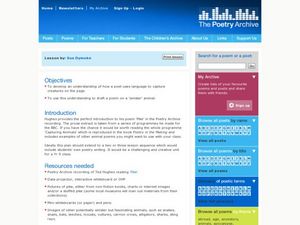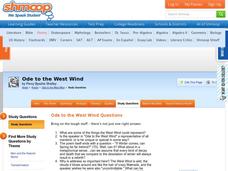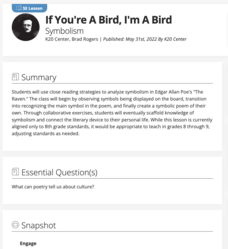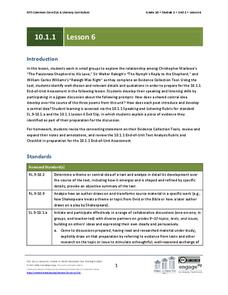Curated OER
Borrowed Inspiration: Writing Social Commentary
Students read poems with social themes. In this poetry analysis lesson plan, students read poems selected by their instructors and complete the provided social commentary chart to determine how the poems speak out against social ills....
Curated OER
Upon the Burning of Our House
Tenth graders read the poem "Upon the Burning of Our House" and complete analysis activities. In this poetry analysis instructional activity, 10th graders read the poem and create original scenes summarizing the stanza.
Curated OER
Ted Hughes "Pike"
Middle schoolers analyze how a poet uses language to capture creatures and draft a poem on a 'sinister' animal. In this poetry analysis lesson, students read Ted Hughes' poem 'Pike' and analyze pictures of pike fish. Middle schoolers use...
Curated OER
Anne Carson
Students read poetry and a biography of poet Anne Carson as part of a creative writing lesson. In this poetry analysis lesson, students read about the poet, read her poetry, and analyze a photograph to then write a poem. Students write...
Curated OER
Mutability Questions
For this poetry analysis worksheet, students read the poem "Mutability," by William Wordsworth and then respond to 6 discussion questions. The questions require students to consider the role of religion and the impact of sudden change as...
Curated OER
The Negro Speaks of Rivers Theme of Memory and the Past
In this poetry analysis worksheet, students read a paragraph regarding Langston Hughe’s use of collective voice in the poem, “The Negro Speaks of Rivers Theme of Memory and the Past.” Students then answer 4 discussion questions about the...
Curated OER
Ode to the West Wind Questions
In this literary analysis worksheet, students read the poem "Ode to the West Wind," by Percy Bysshe Shelley and then respond to 5 short answer discussion questions about the significance of wind in the poem and the symbolism of...
Curated OER
"Thank You Ma'am" by Langston Hughes
Students use Langston Hughes' "Thank You Ma'am" as a reading and vocabulary improvement activity. In this reading and vocabulary lesson, students review the related vocabulary and read the poem. Students discuss the story elements in the...
Curated OER
The Road Not Taken
Students analyze Robert Frost's poem "The Road Not Taken." In this poem analysis lesson, students review vocabulary for the poem and read the poem. Students discuss the meanings in each stanza, the theme, and its rhyme scheme. Students...
Curated OER
My Last Duchess Questions
In this literary analysis worksheet, students examine Robert Browning's "My Last Duchess," as they read the poem and respond to 6 short answer questions.
Curated OER
Interaction as Analysis: Emily Dickinson
Emily Dickinson’s “Hope is a thing with feathers” is the focus of a series of activities that model for learners how close reading can lead to understanding. The whole class plays with the metaphor, groups talk about the author’s...
Fabius-Pompey School District
Paired Passage Practice and the Extended Response Question
How do pupils relate paired passages to each other? Here's a resource that helps! The lesson includes a short story and a poem as a set of paired reading passages, followed by some analysis questions. It also includes an essay template...
K20 LEARN
If You're a Bird, I'm a Bird: Symbolism
Would a bluebird be as scary as a vulture? Edgar Allan Poe's "The Raven" is the central text in a lesson plan about symbolism. After a close reading of the poem, learners consider what the raven might represent to the narrator. They then...
EngageNY
Looking Closely at Stanza 1—Identifying Rules to Live By Communicated in “If”
Here is a lesson plan in which pupils connect themes and rules to live by from the story Bud, Not Buddy by Christopher Paul Curtis to those found in the poem If by Rudyard Kipling. First, scholars discuss their reading and review Bud's...
EngageNY
Introducing “If” and Noting Notices and Wonders of the First Stanza
After reading chapter 14 of the story Bud, Not Buddy by Christopher Paul Curtis, scholars take part in a read-aloud of the poem If by Rudyard Kipling and compare it to the reading of Bud, Not Buddy. Learners then go deeper into the poem...
Center for History Education
How Did the Public View Women’s Contributions to the Revolutionary War Effort?
Calling upon the legacies of Joan of Arc, Elizabeth I, and Catherine the Great, Esther Reed rallied Southern women to support the American Revolution. Using a broadside by Reed and other primary sources, such as poetry, young historians...
Soft Schools
Practice Reading Poetry
Identify the rhyme scheme in a activity that features "Mary Had a Little Lamb." Readers use the nursery rhyme to reinforce poetic elements in four comprehension questions.
EngageNY
Looking Closely at Stanza 2—Identifying Rules to Live By Communicated in “If”
Pupils take part in a close reading of the poem, If by Rudyard Kipling, in which they delve deep into its meaning and identify its rules to live by. As the grand discussion progresses, learners then relate the poem's rules with those...
EngageNY
Notices and Wonders of the Second Stanza of “If”
Here is an instructional activity that asks pupils to analyze poetry and sparks discussion about two different types of texts: asking how is the poem, If by Rudyard Kipling alike and different from the story, Bud, Not Buddy by...
EngageNY
Grade 10 ELA Module 1: Unit 1, Lesson 6
Wrap up your literary analysis unit with a discussion activity as tenth graders prepare for an end-of-unit assessment. After they have read and annotated Christopher Marlowe's "The Passionate Shepard to His Love," Sir Walter Raleigh's...
Academy of American Poets
The Immigrant Experience
The Buttonhook by Mary Jo Salter is the focus of a unit that explores the immigration experience to Ellis Island. First, scholars bring in an artifact that represents their heritage. A group-exercise allows them to share and discuss...
K20 LEARN
Memory Haiku: The Great Gatsby and the Sense of Smell
Scholars learn how smells evoke early childhood memories and apply that knowledge to a character from F. Scott Fitzgerald's The Great Gatsby. After finding a passage from the novel that references smells, they craft a haiku and a...
EngageNY
Looking Closely at Stanza 3—Identifying Rules to Live By Communicated in “If”
Just as Bud, from the novel Bud, Not Buddy by Christopher Paul Curtis, had rules to live by, so does the poem, If by Rudyard Kipling, but how do the two relate? Pupils delve deep into the poem's third stanza, participate in a grand...
EngageNY
Analyzing, Comparing, Sharing: Modern Voices
What do modern voices sound like? Scholars explore the topic, reading two concrete poems from John Grandit's Blue Lipstick and analyzing them using a graphic organizer. Next, they read a third poem and work with partners to look for...























